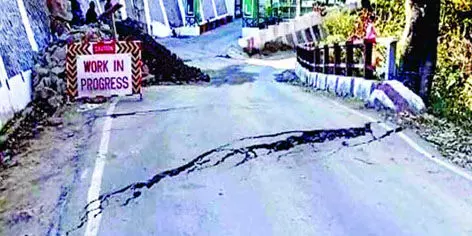
Uttarkashi, Nainital also at risk of sinking like Joshimath, say experts
text_fieldsNew Delhi: Experts have warned that more towns in Uttarkhand are vulnerable to land subsidence, meaning they could sink the way Joshimath does.
The ground collapsing in Joshimath, the gateway to the famed spiritual places including Badrinath and Hemkund Sahib, has come as a shock to many.
But land subsidence has never been a matter of concern when foothills of Himalaya were massively built over, thanks to being a tourist destination.
Now that land is giving away from the weight building that popped up, reports say ‘Land subsidence is one of the biggest overlooked environmental consequences’, according to India Today.
Blame the human activity that continued uncontrolled without any regard for ‘geology of the local region’.
The land underneath Joshimath is moving in part because of the ‘weak foundation and enhanced toe erosion from rainfall and floods’ in the area.
Reports attribute the triggering of land sinking to the reactivation of the Main Central Thrust (MCT-2).
To expand further, this geological fault is where the Indian Plate has pushed under the Eurasian Plate along the Himalayas, according to India Today.
Dr Bahadur Singh Kotlia, Professor of Geology at Kumaun University, warned that Joshimath is not going to be the only place to experience the natural disaster.
"This MCT-2 zone has reactivated, which is causing the sinking of ground in Joshimath and no geologist can predict when this reactivation will happen. We have been warning governments for two decades now, but it was all ignored till now. You cannot fight geology, you cannot fight and win with nature,"Dr Kotlia reportedly said.
Dr Kotlia added the events in Koshimath could happen in areas including Nainital, Uttarkashi and Champawat, which are highly prone to seismic activity and reactivation of faultlines alongside stress from increasing population and construction activities.
The foundation of these cities is very poor, making them very vulnerable,” Dr Kotlia warned.
Nainital in particular is experiencing heavy tourism that led to massive construction in the area.
A 2016 reports, according to India Today, said that half of the township was covered with debris from landslides.
A study by Dr Kotla released last year pointed out the vulnerability of the area after analyzing the 2009 Balia Nala Landslide, according to the report.
The researchers from Wadia Institute of Geology and Graphic Era Hill University found in the geological study in Nainital that the area is mainly made up of limestone with shale and slate.
These highly crushed and weathered rocks, particularly due to the presence of the Nainital Lake Fault, have very low strength, meaning they could crumble replicating the events happening in Joshimath.






